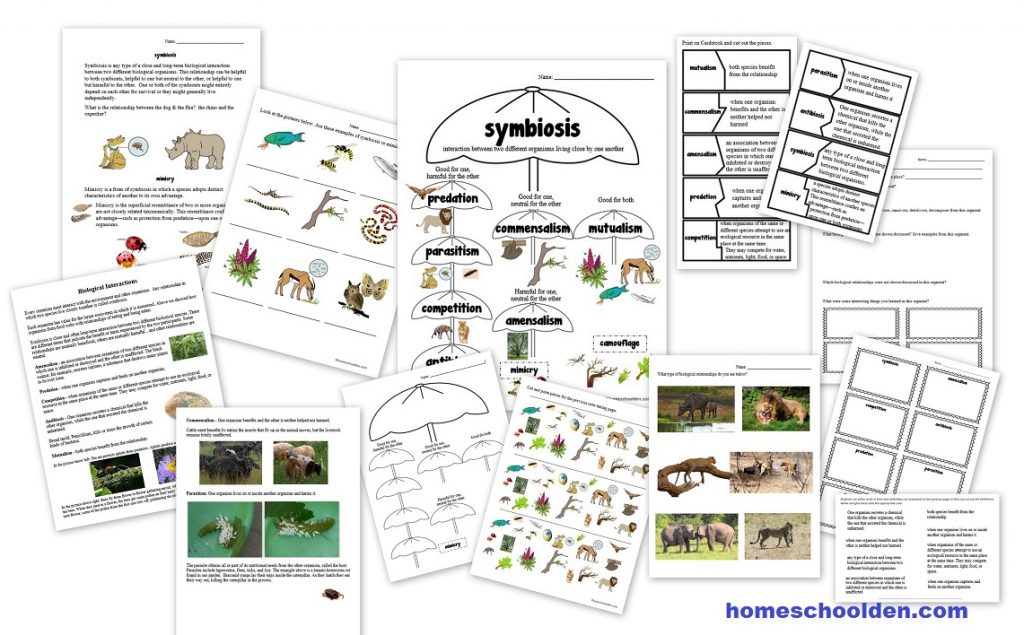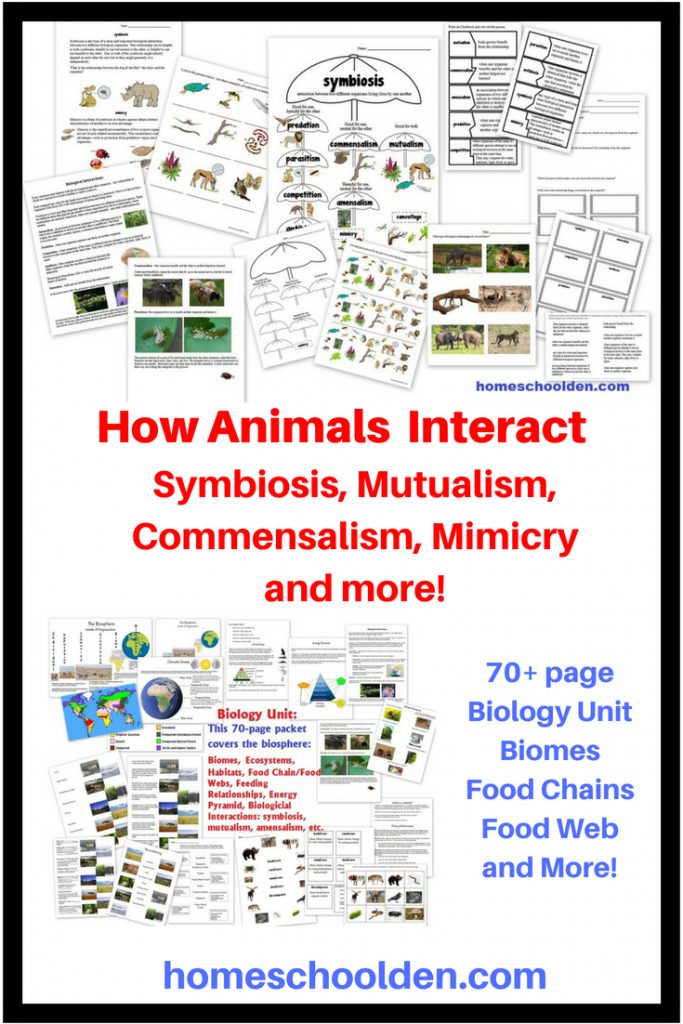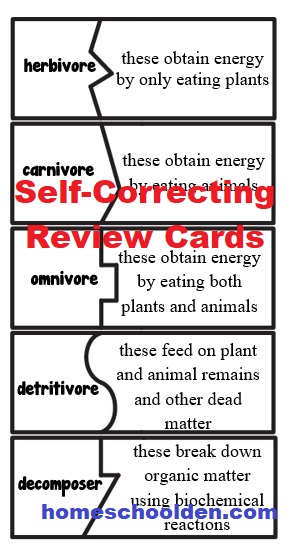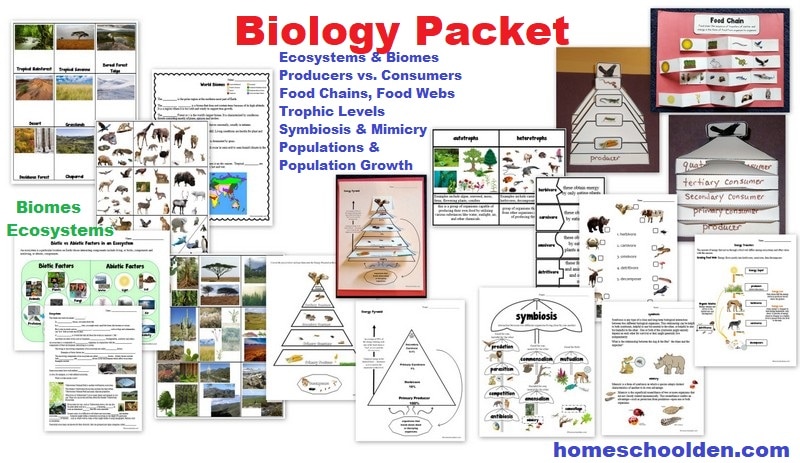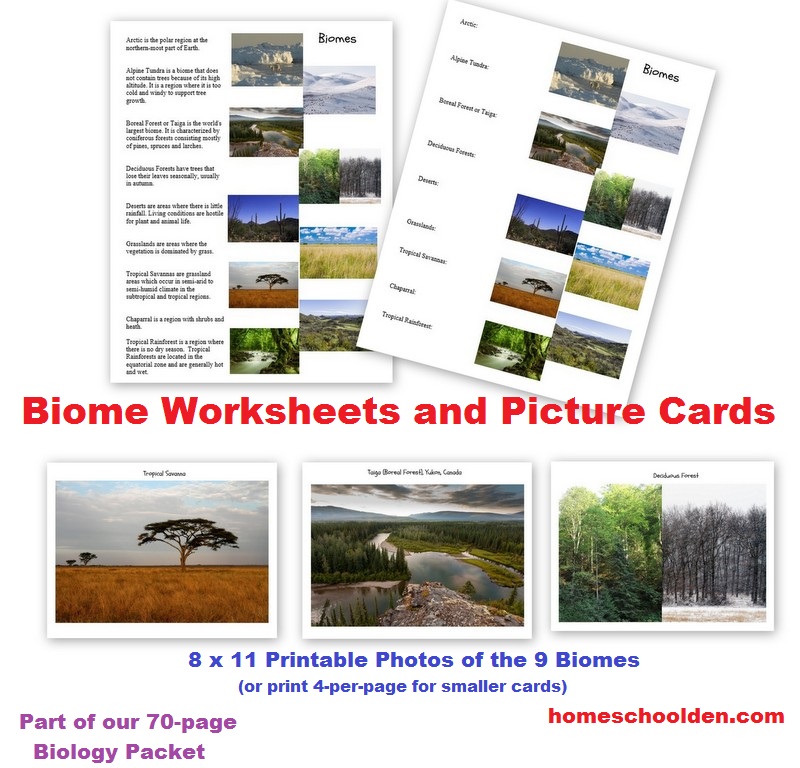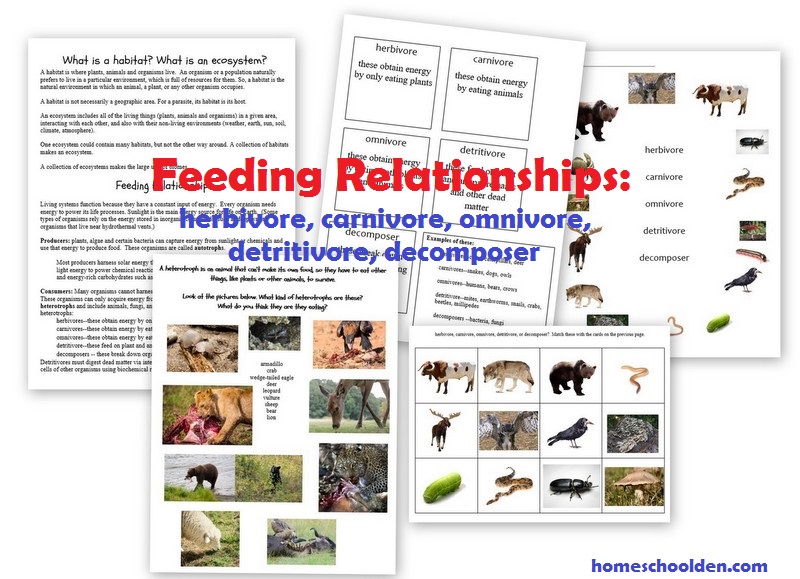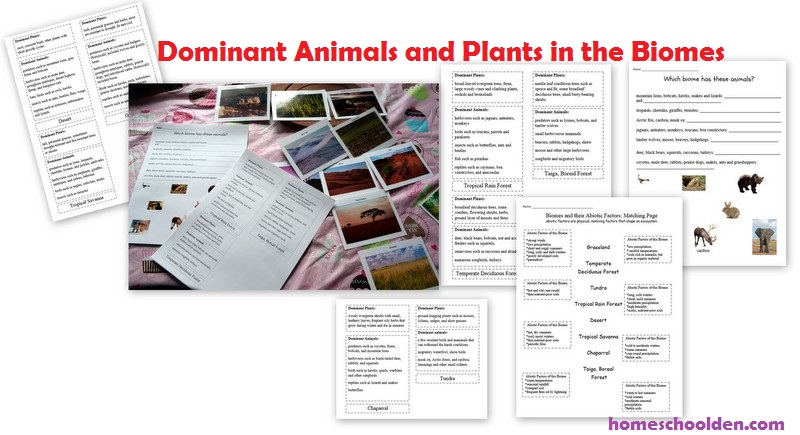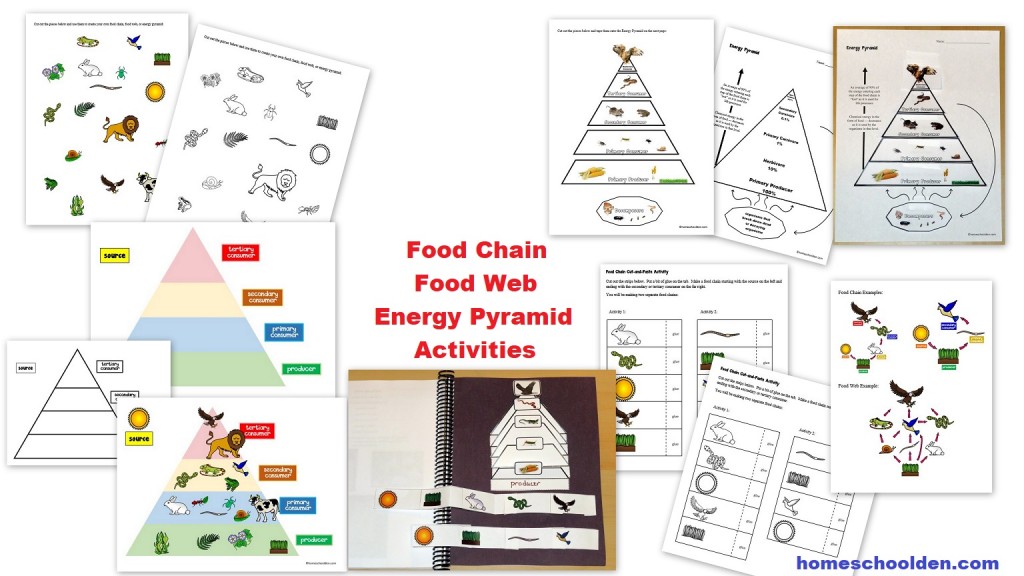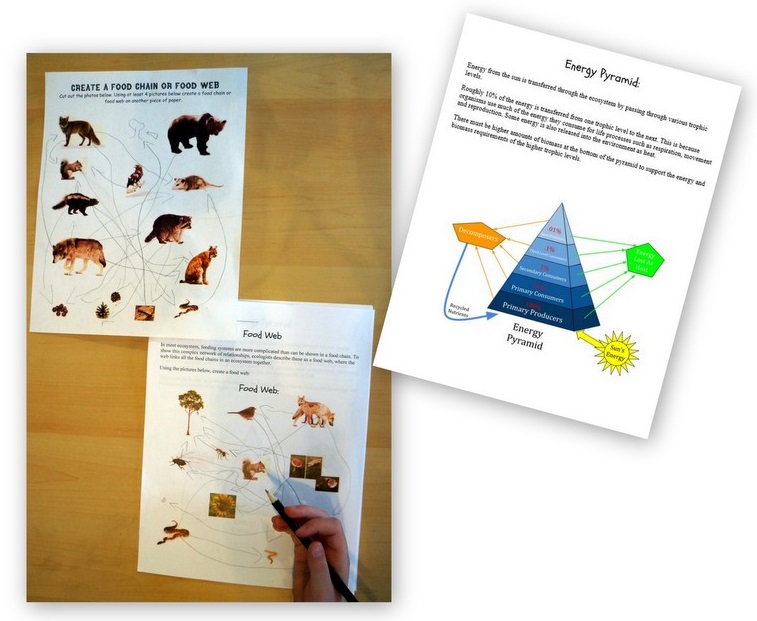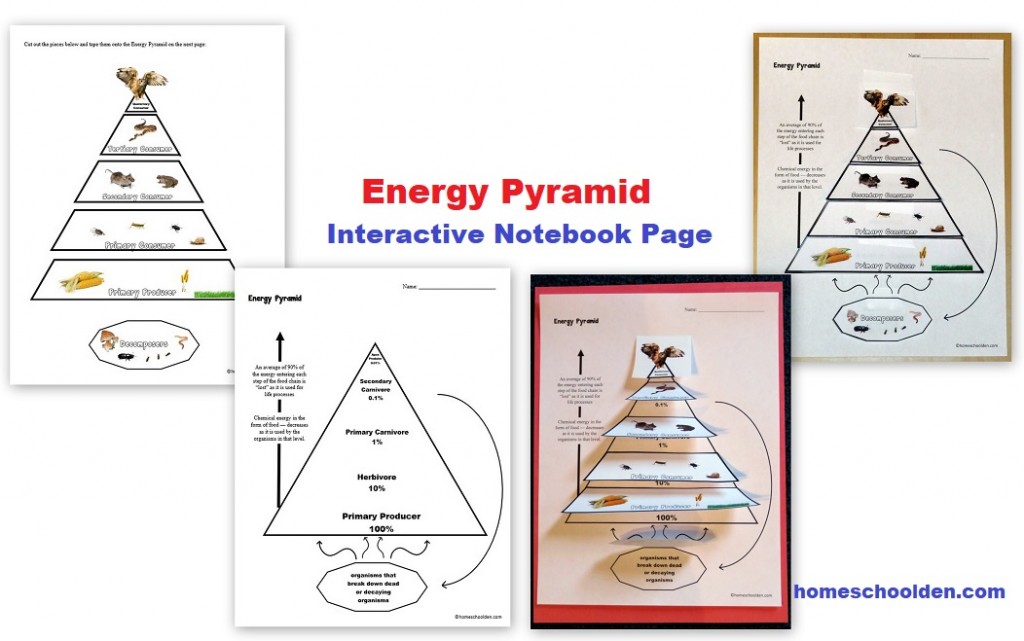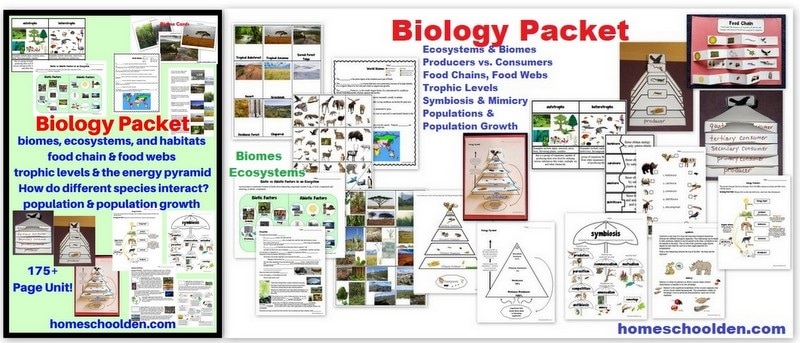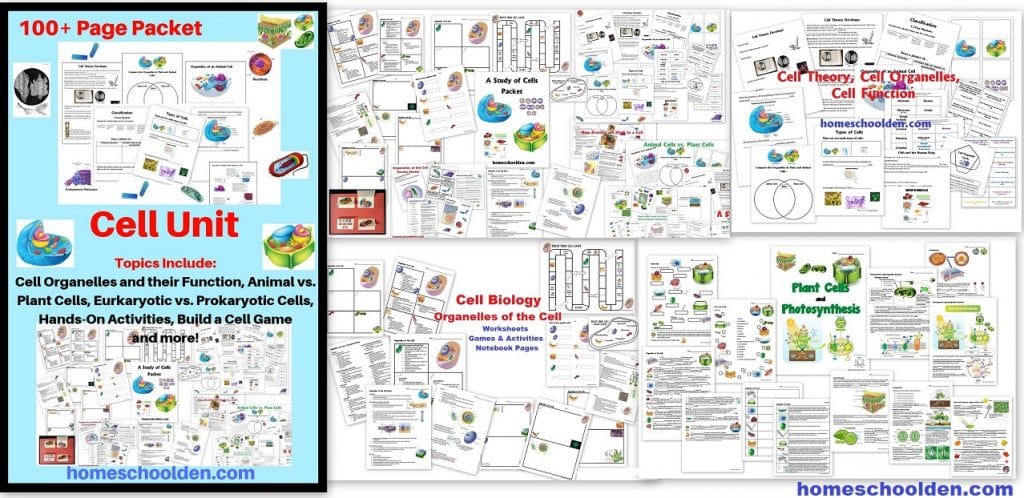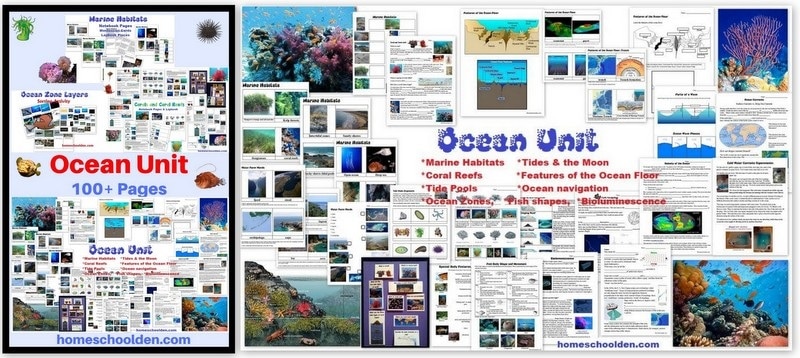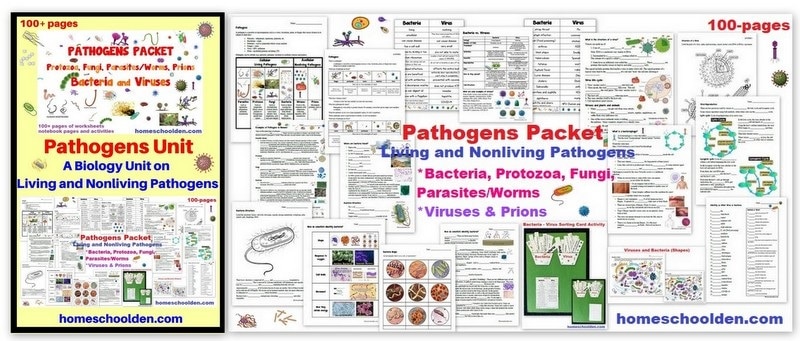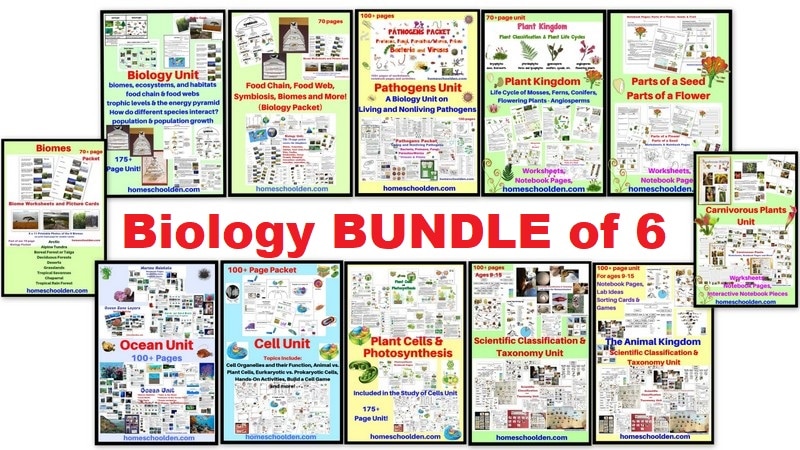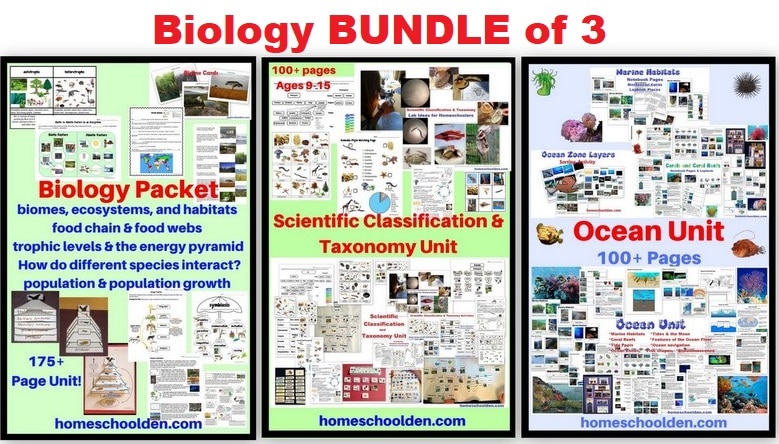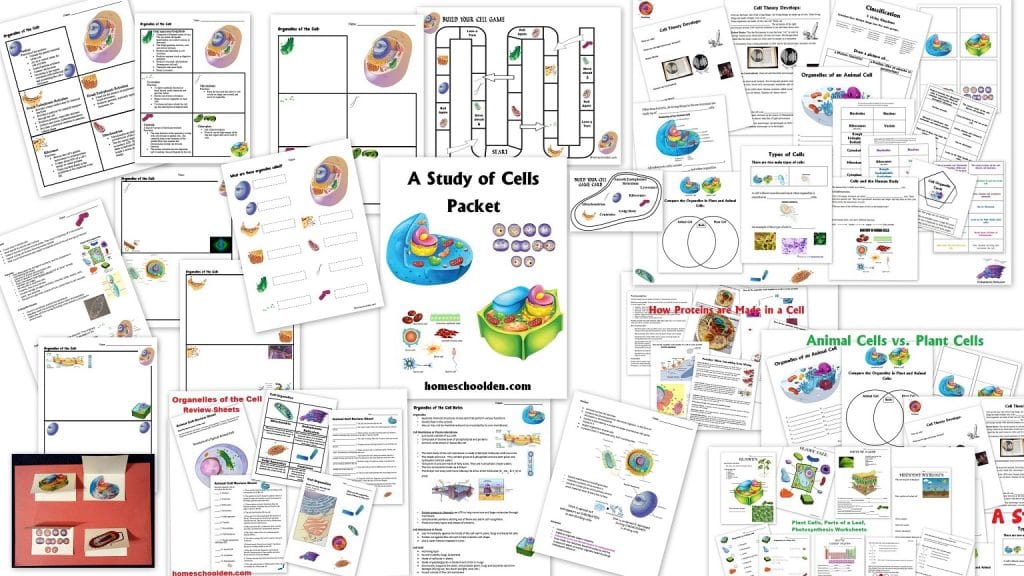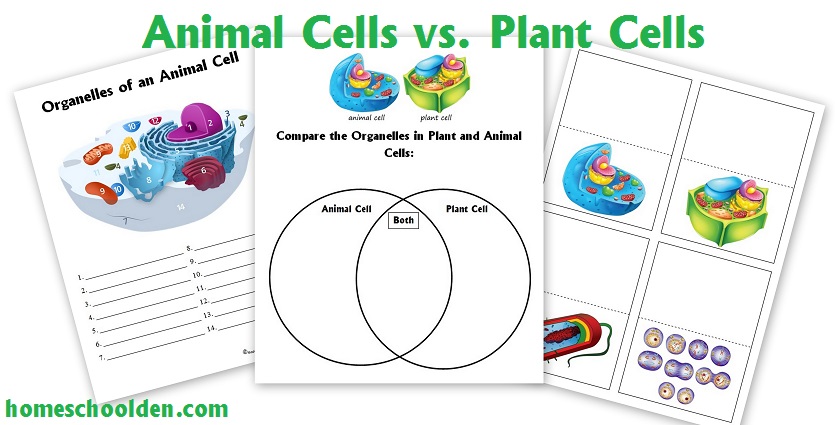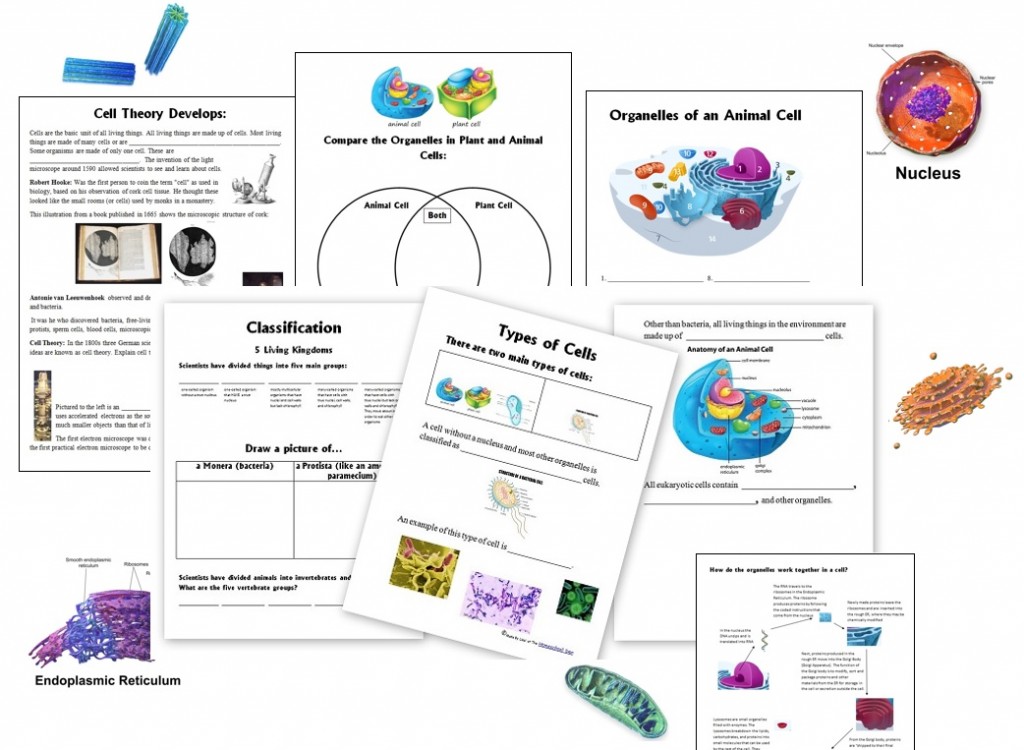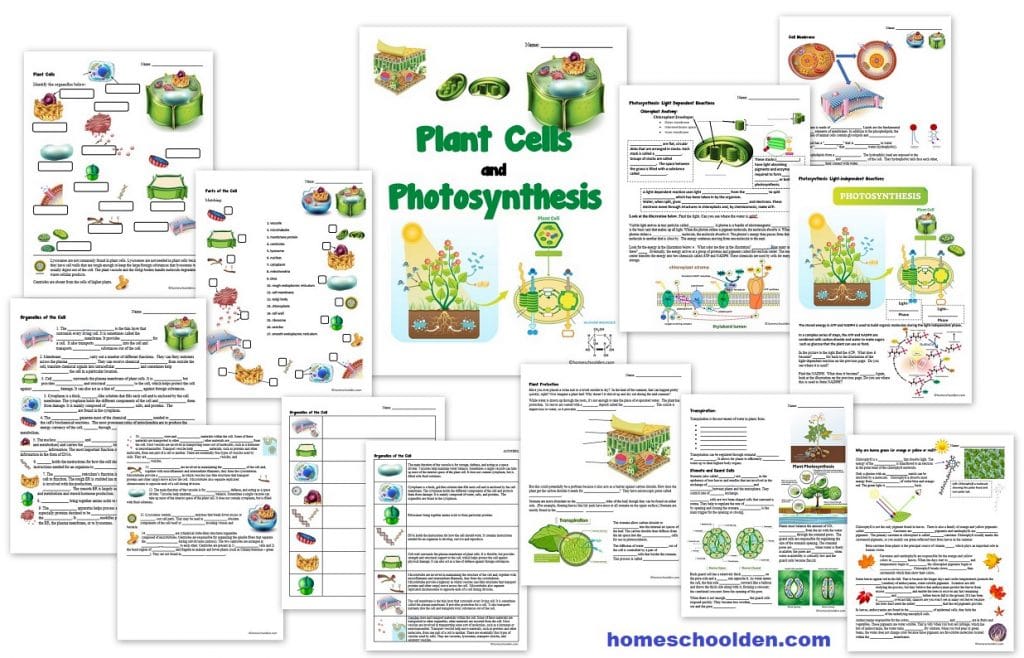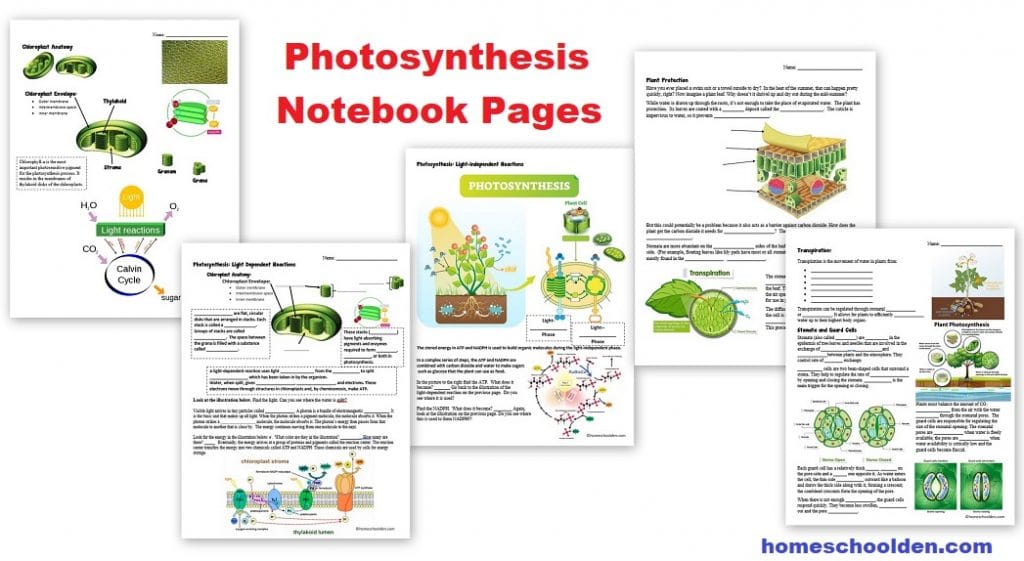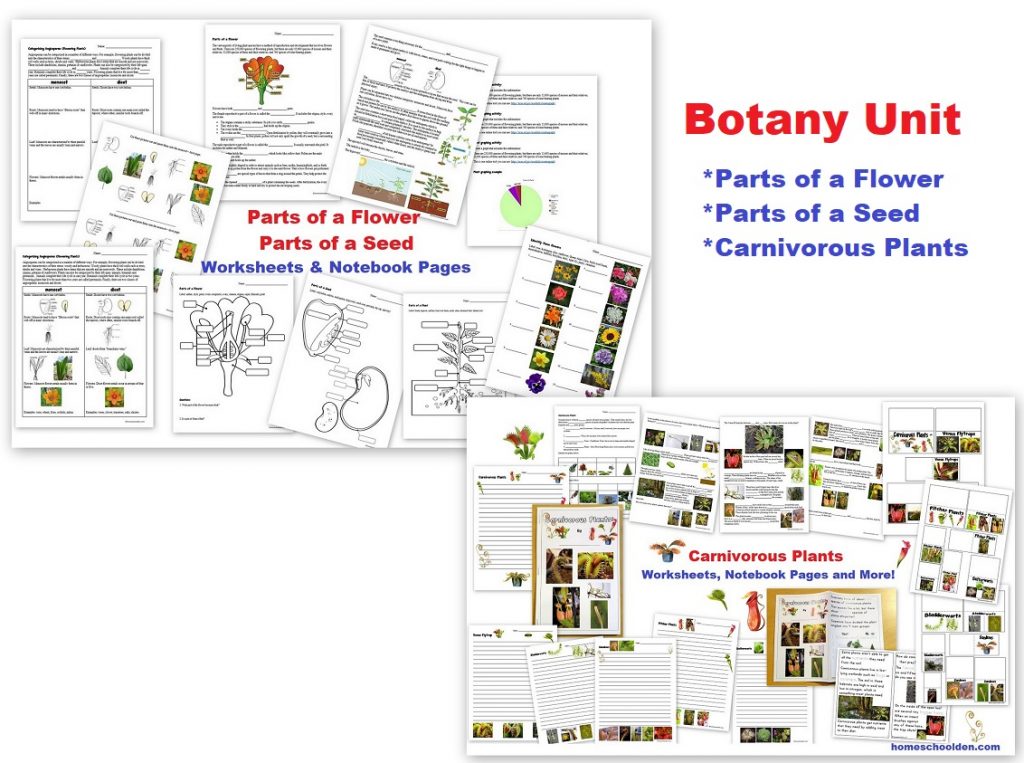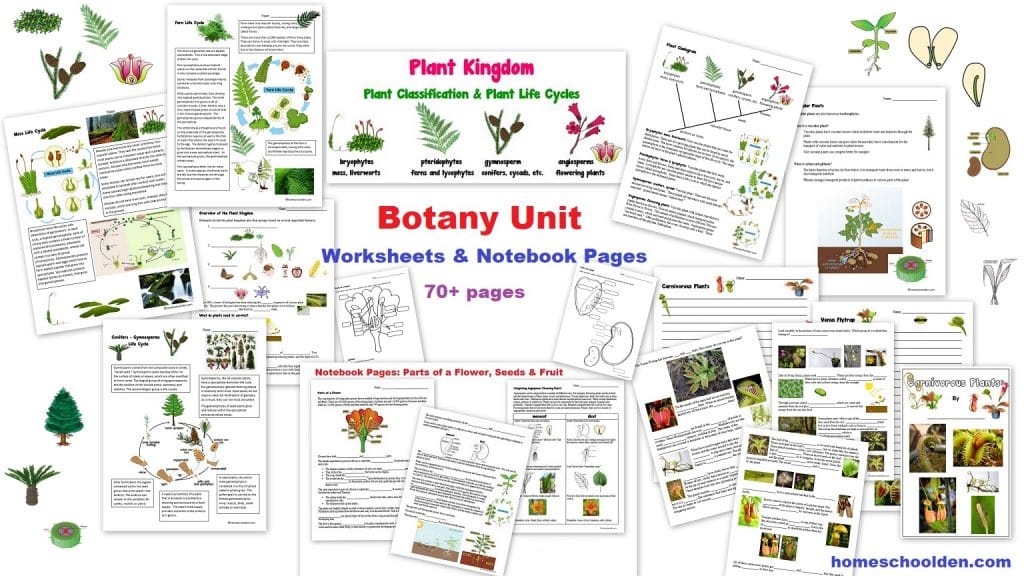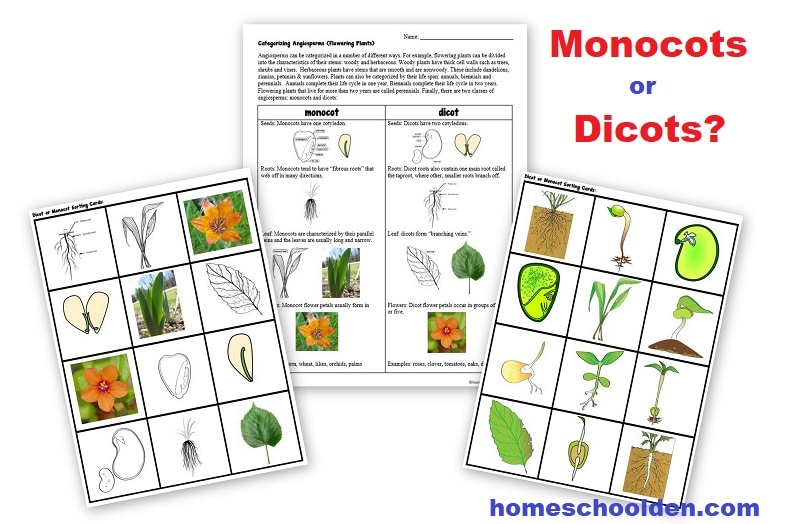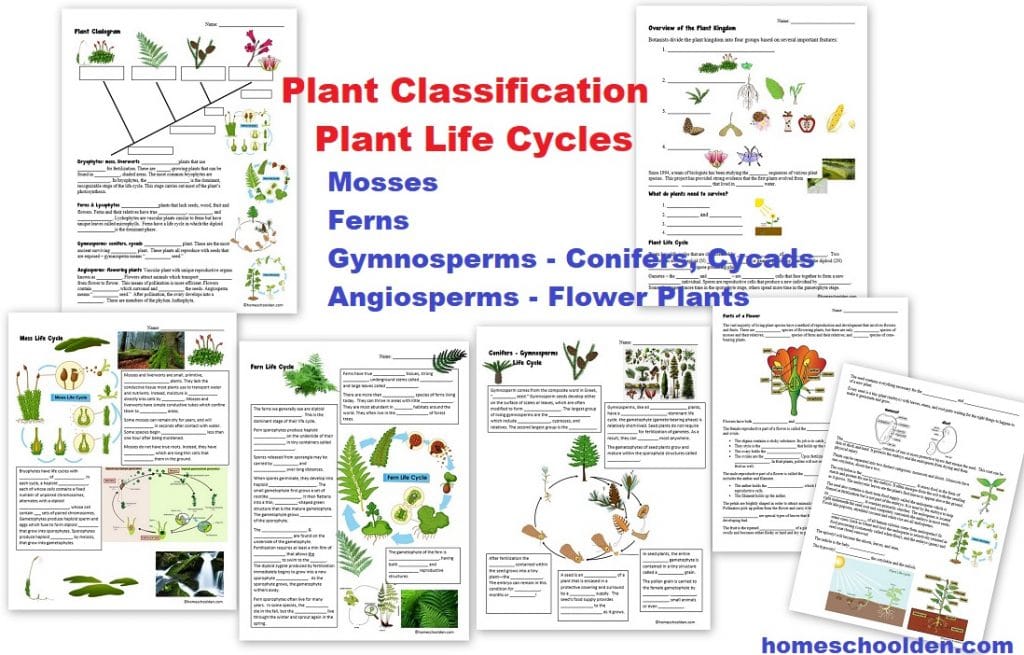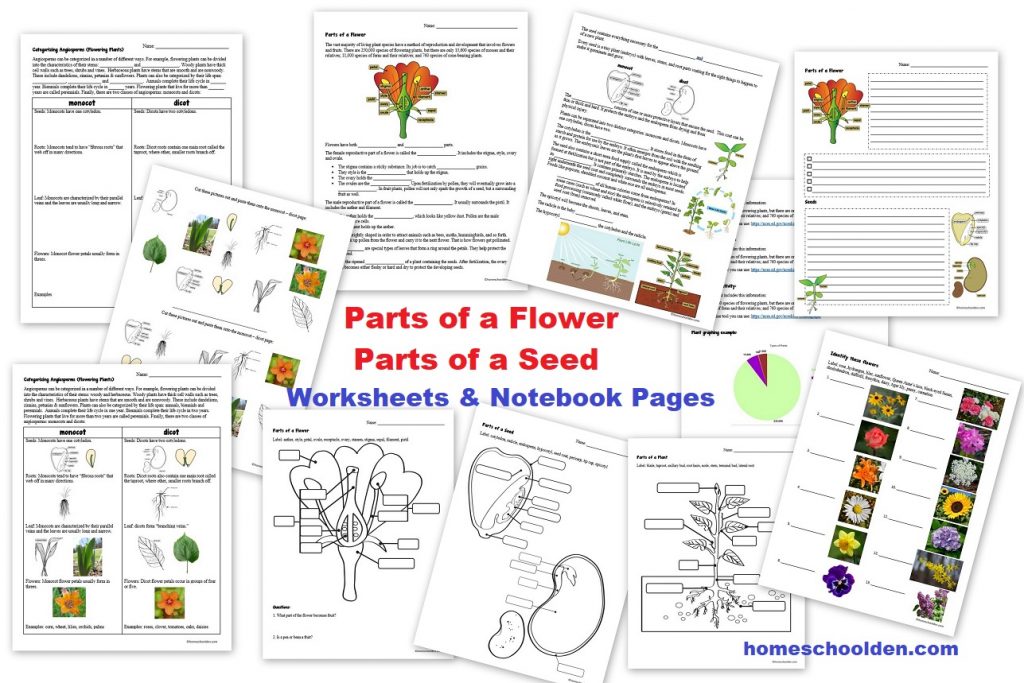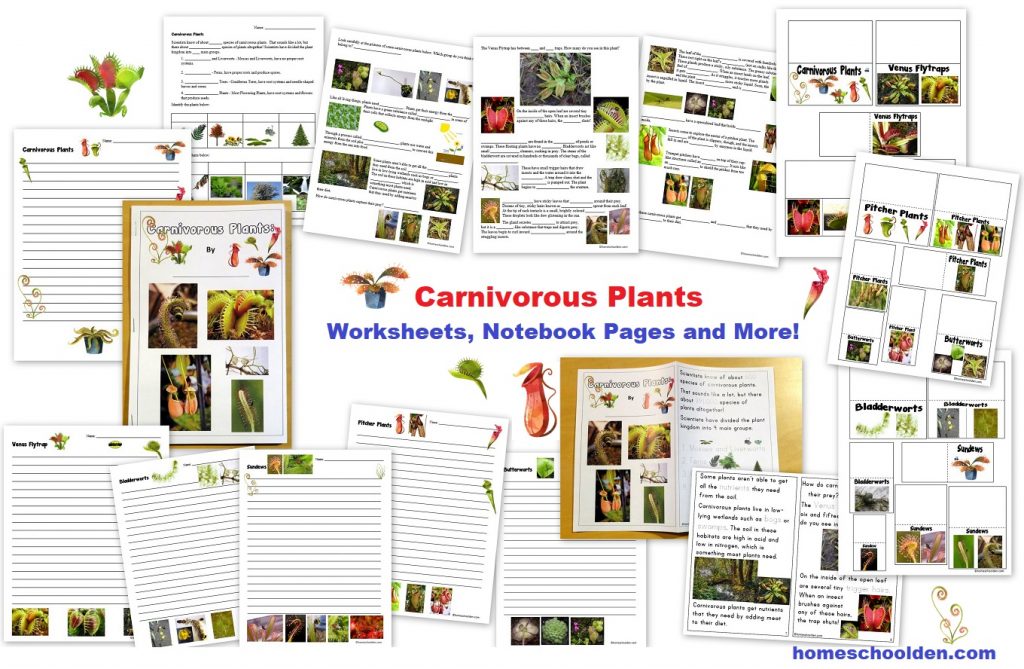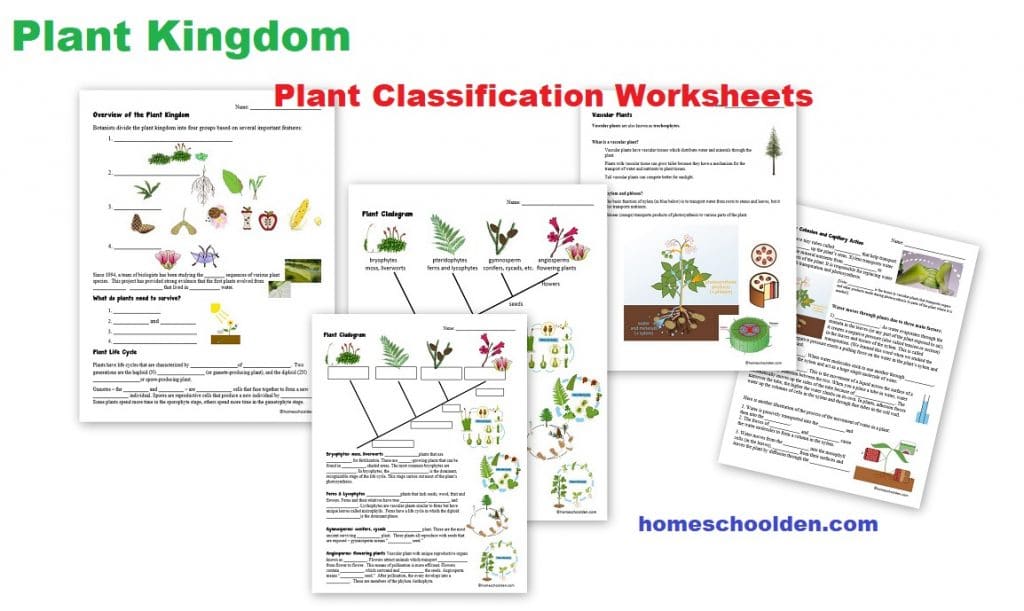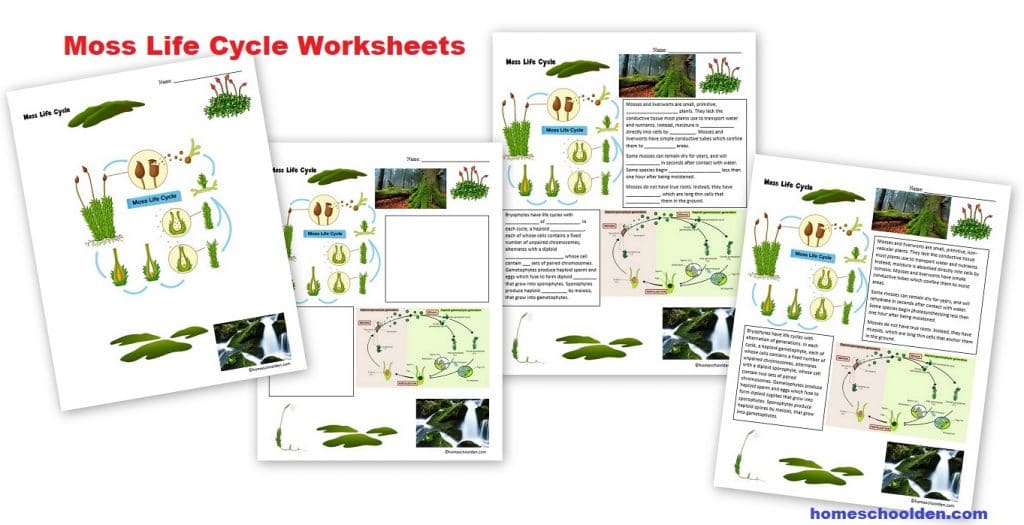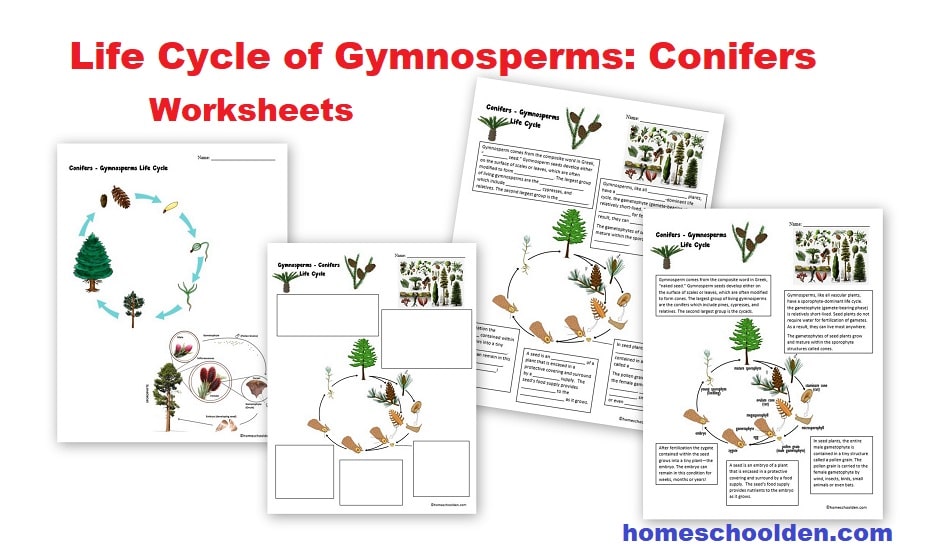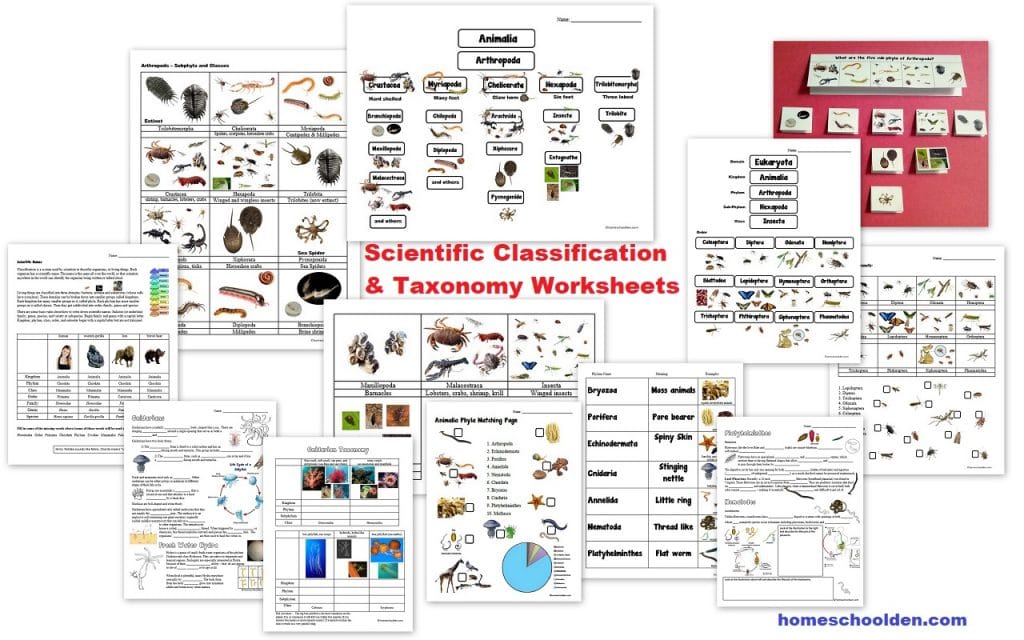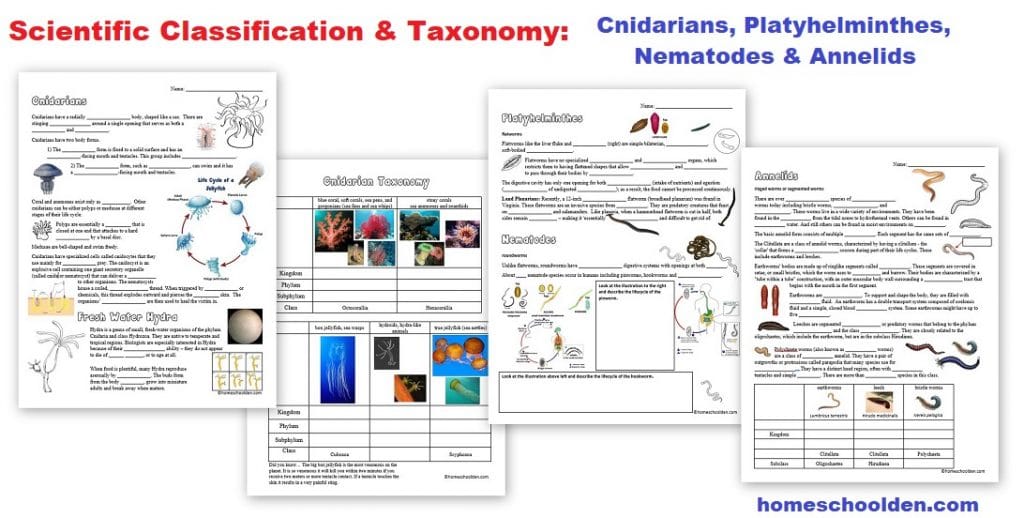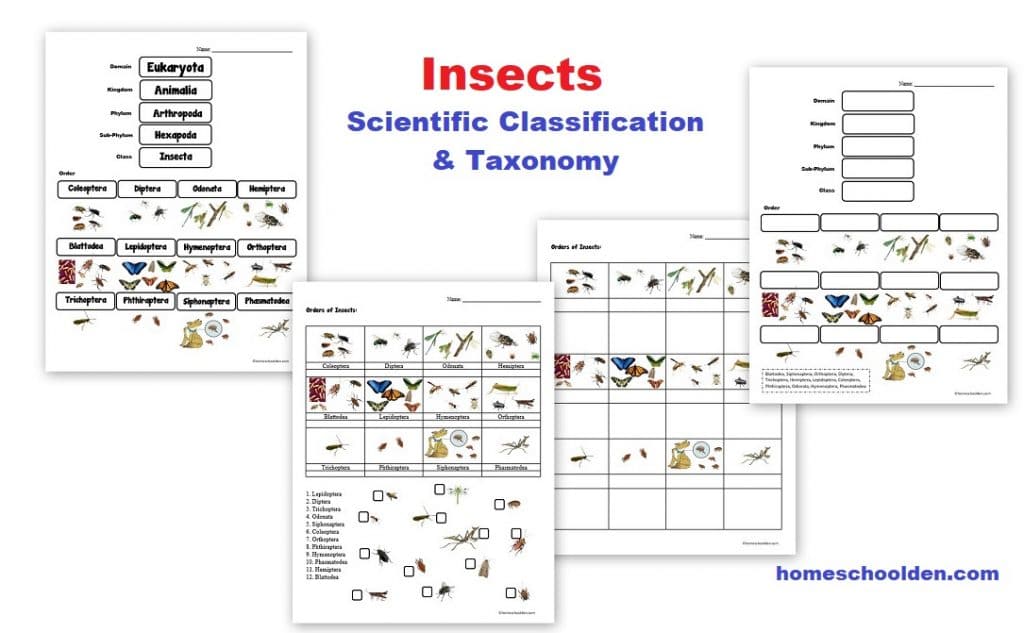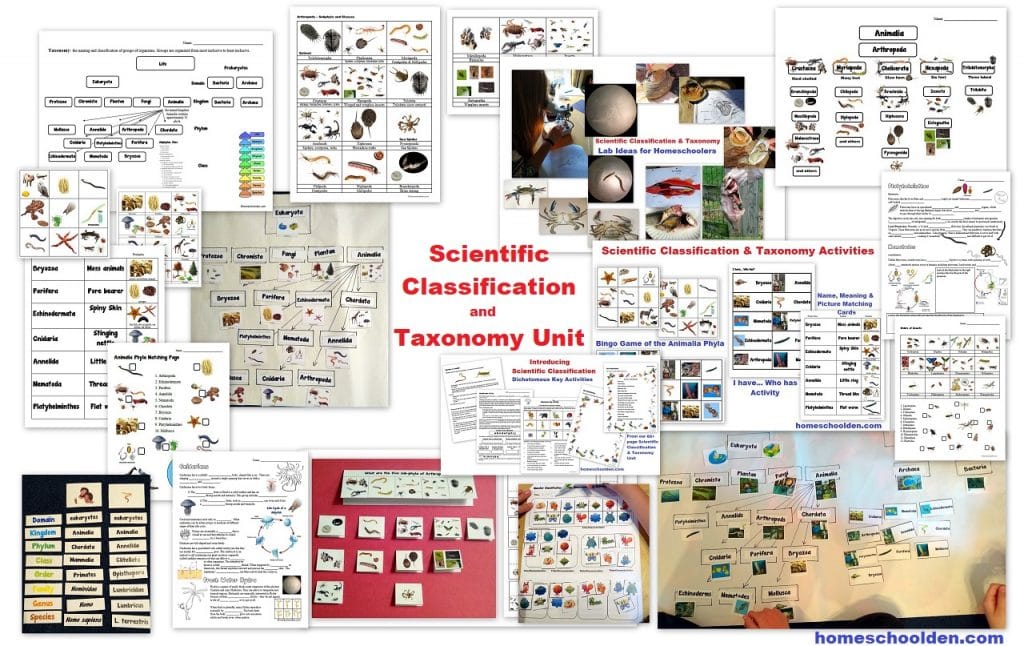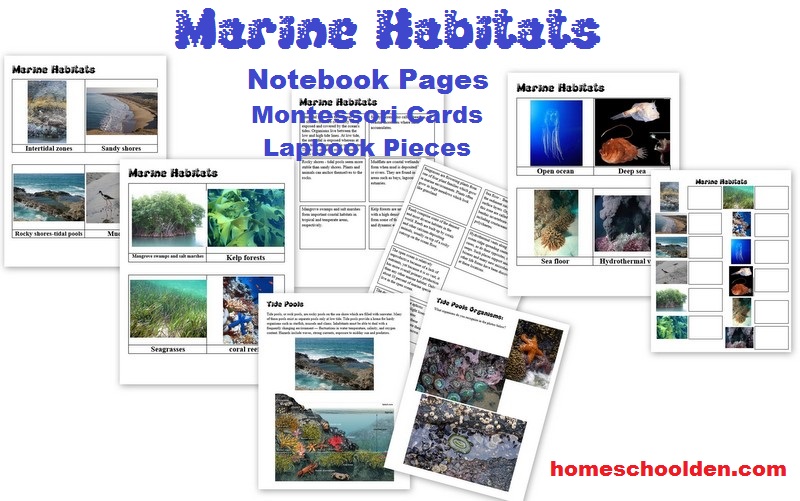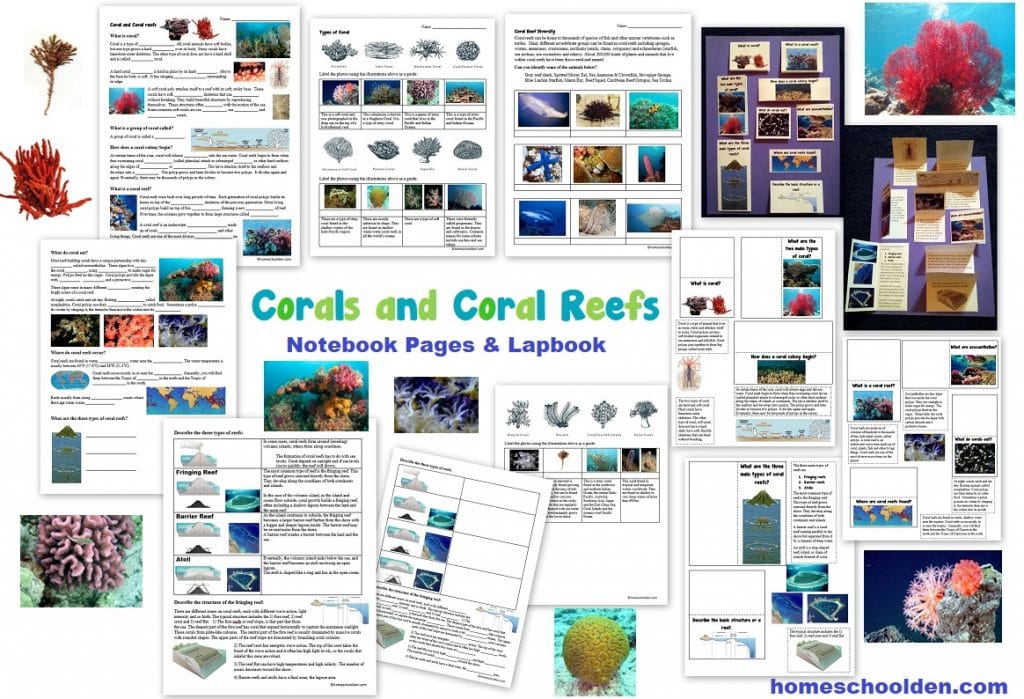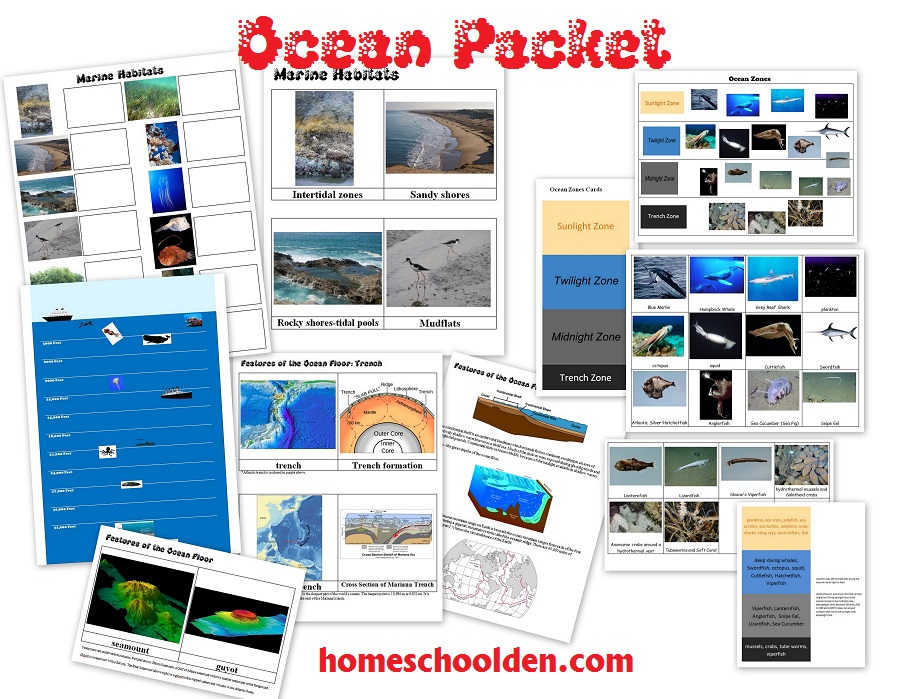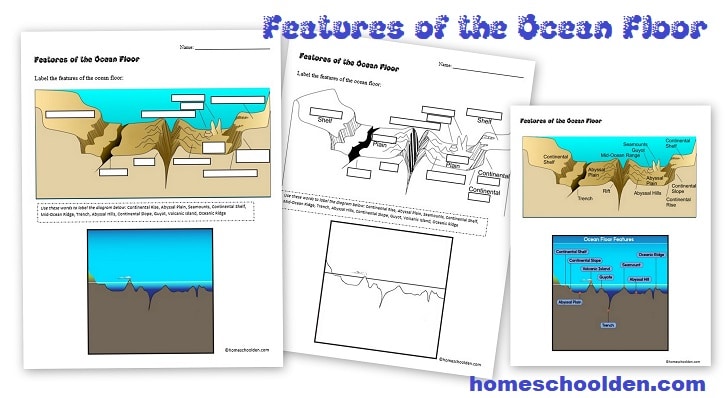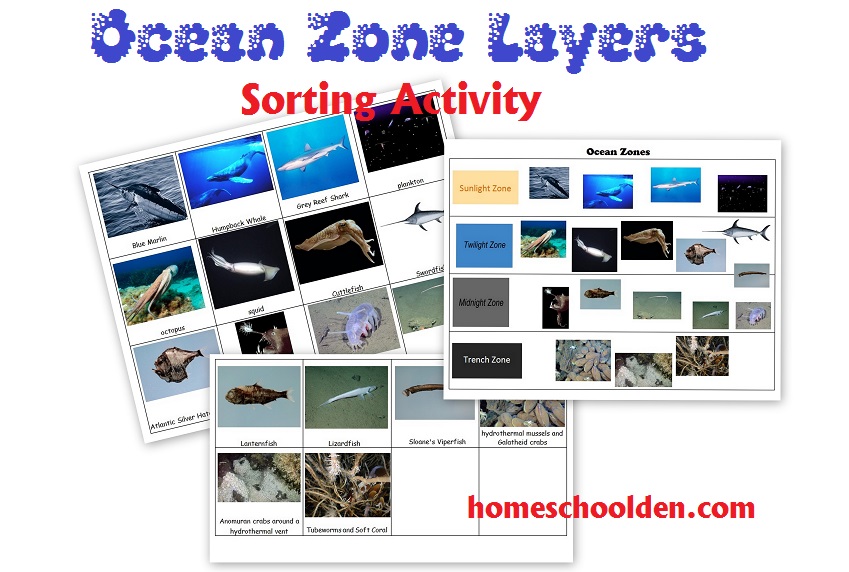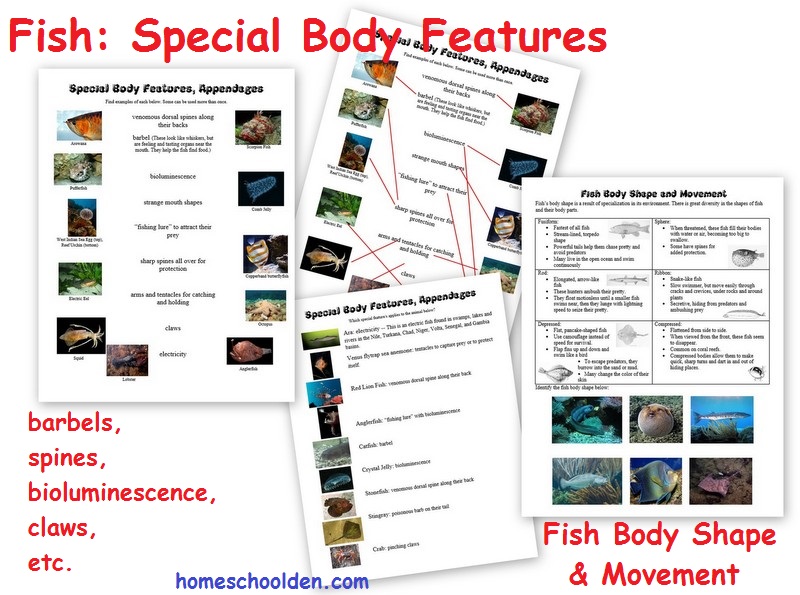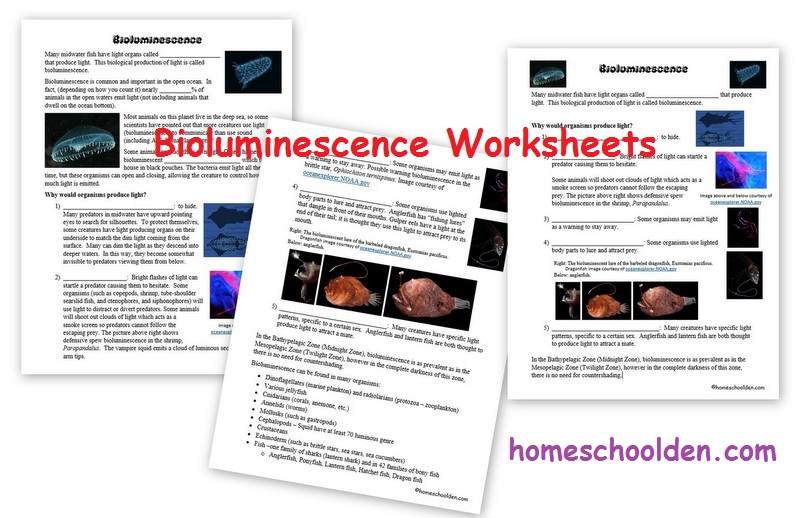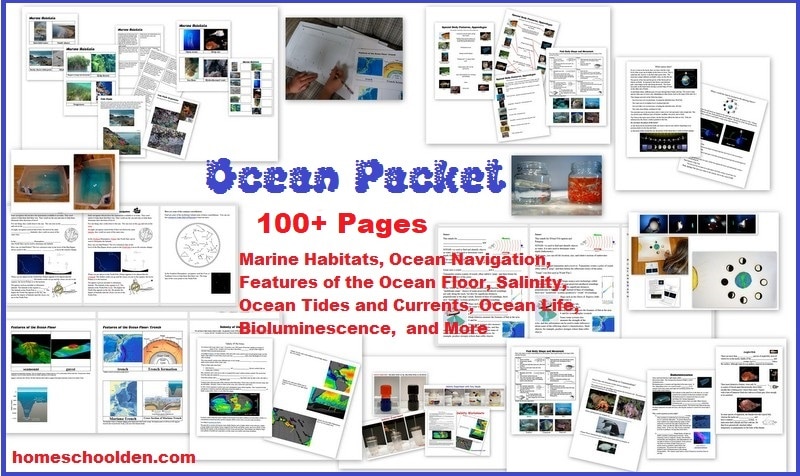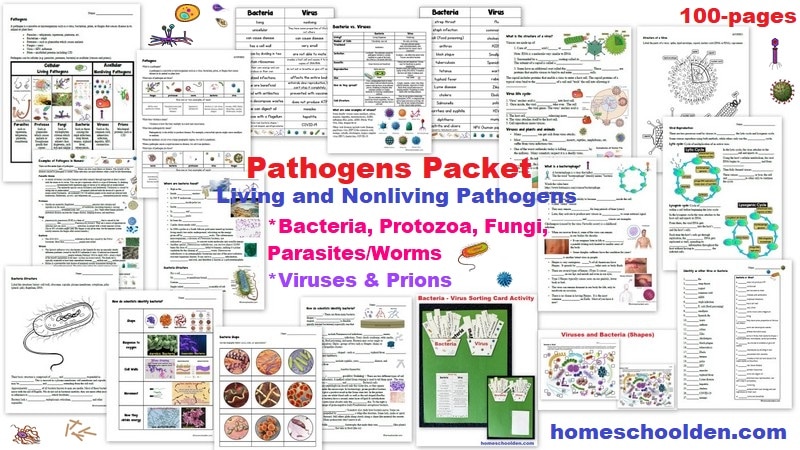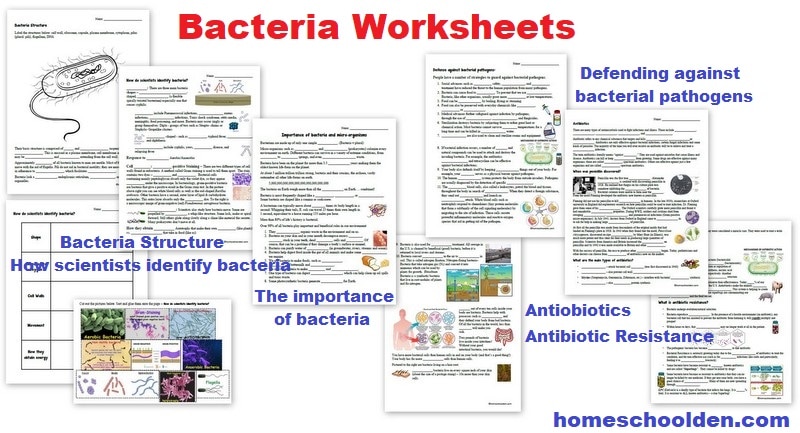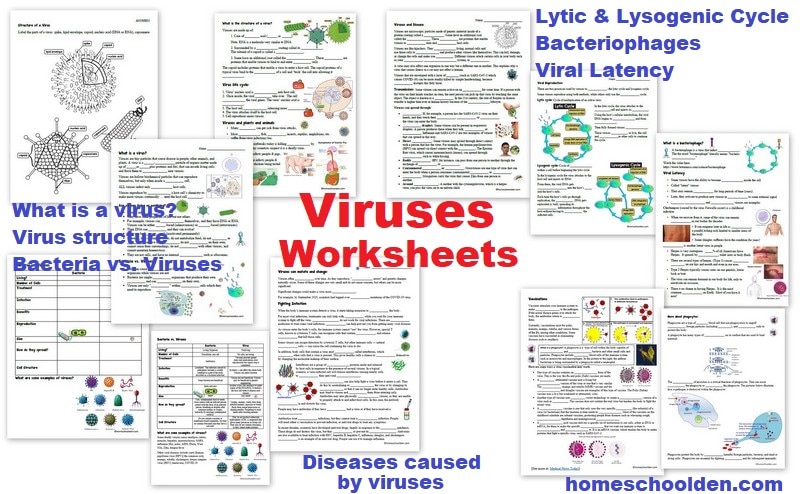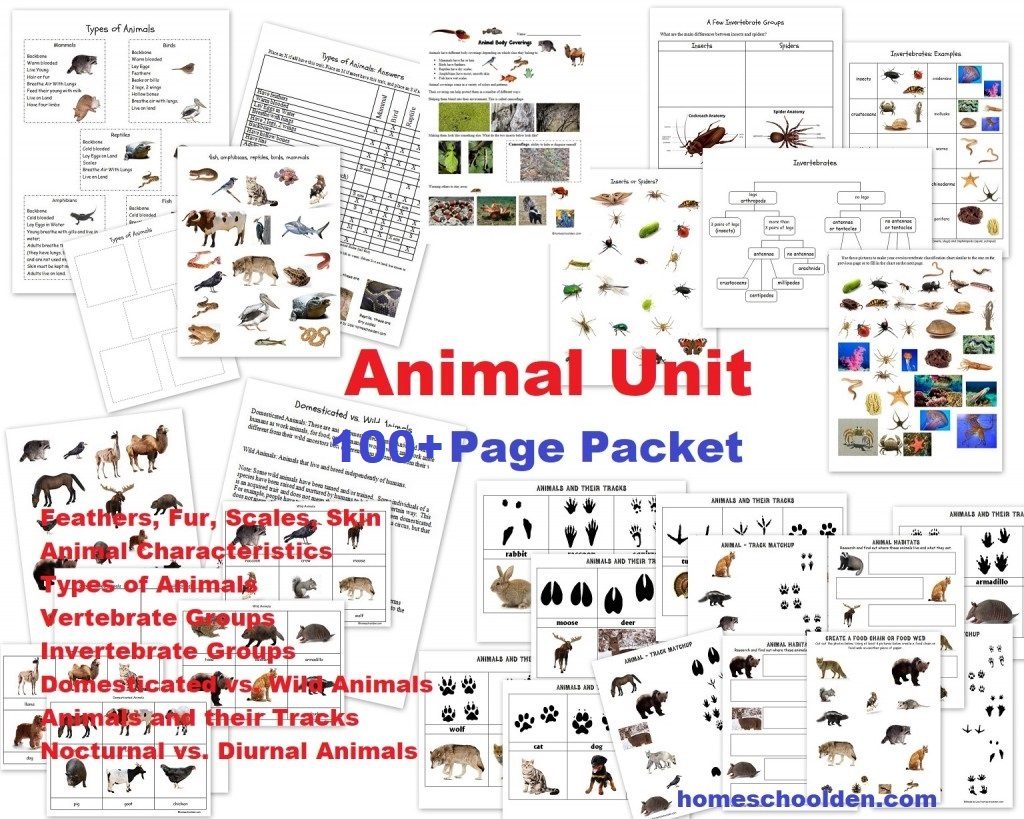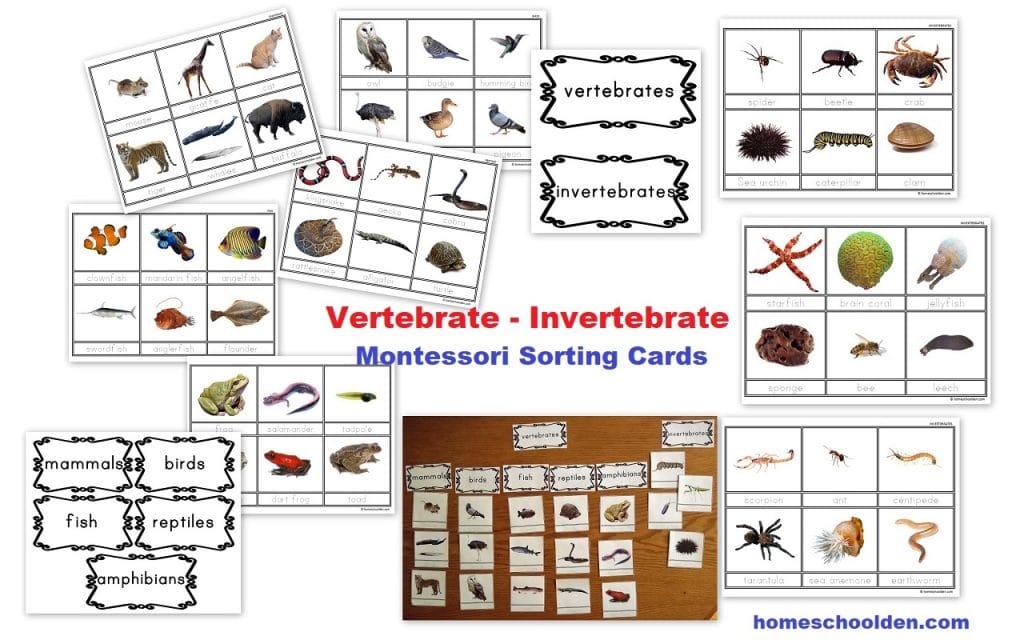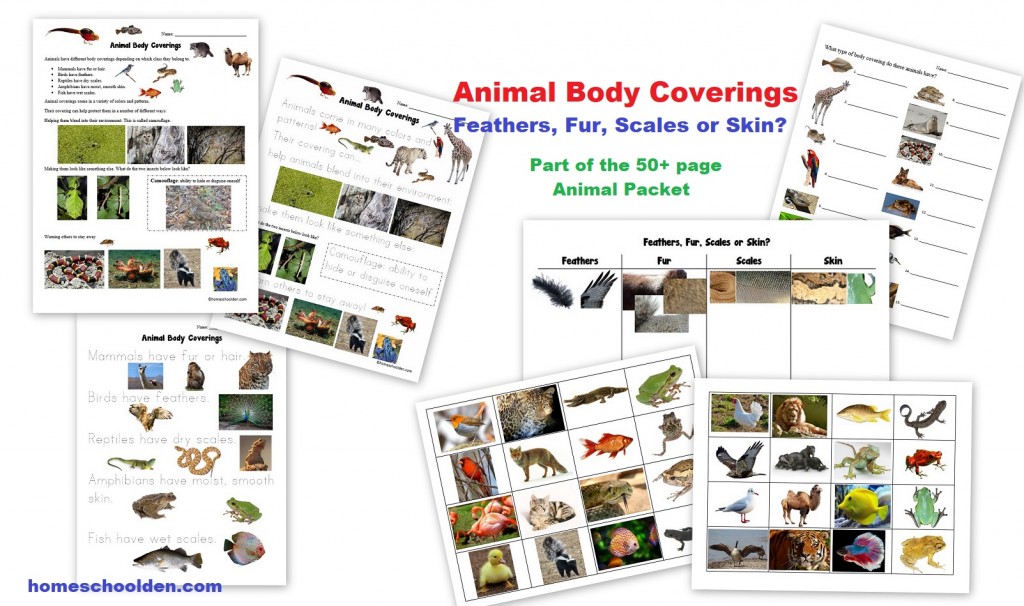Symbiosis, Commensalism, Mutualism, Parasitism, Mimicry Biology Worksheets and Notebook Pages
I have added new worksheets and other activities on symbiosis, commensalism, mutualism, parasitism, mimicry and similar topics to the Biology Packet today! In all, I added about 20 new pages, so the Biology Packet is now well over 170 pages! I also added in some matching review cards for how organisms derive their energy and nutrient requirements: herbivores, carnivores, omnivores, detritivores, decomposers as well as for the terms above.
I will be covering this material with my 10-year-old (5th grader) this semester and wanted to go over these biological relationship terms (and others) with her.
We will be starting with a general discussion of symbiosis, which is the interaction between two different organisms living close by one another. Before we go into depth about the different relationships, we’ll look at symbiosis (in a general way) and mimicry (a defense mechanism).
Click here to save it for later on Pinterest:
From there, we’ll go into more detail about the different biological relationships: This relationship can be helpful to both symbionts, helpful to one but neutral to the other, or helpful to one but harmful to the other. One or both of the symbionts might entirely depend on each other for survival or they might generally live independently. And, we’ll go over the specific terms for these:
- predation
- parasitism
- competition
- antibiosis
- commensalism
- amensalism
- mutualism
In this latest update, I added in some self-correcting review cards both for how organisms derive their energy and nutrient requirements: herbivores, carnivores, omnivores, detritivores, decomposers as well as for the terms above.
More details about this Biology Packet and how to purchase it:
Just as a reminder, this Biology Packet covers
- a discussion of the difference between biomes, ecosystems, and habitats
- the three main climate zones
- the abiotic factors of each biome — ie. the physical, nonliving factors that shape an ecosystem
- dominant animals and plants in each biome
- feeding relationships — producers and consumers (autotrophs and heterotrophs). And, we talked about the different feeding relationships: herbivores, carnivores, omnivores, detritivores and decomposers
- biological interactions:
- Amensalism
- Predation
- Competition
- Antibiosis
- Mutualism
- Commensalism
- Parasitism
- New Material: About 50 pages were added to the latest update and includes new materials about population and population growth.
Here are a few more pictures of material in this unit:
This 170+ page packet is $8.99 and contains all the materials mentioned above and the new material on populations and population growth.
Remember you can also get this in the Biology Bundle of 6! Details here, below or in Our Store!)
Our units are PDF downloads. Be sure to check your PayPal email address for the download link. If you have any questions or problems feel free to email me! You should get your automatic download link from SendOwl within a few minutes. If you don’t, be sure to email me if you need me to send the link to you again! Here are some answers to some Frequently Asked Questions. ~Liesl
Again, this packet is included in the Biology Bundle (see details below).
Biology Packet on the Biosphere: Biomes, Ecosystems, Habitats, Feeding Relationships, Biological Interactions and More!
Biology Packet: $8.99
Don’t forget to check your PayPal email address for the download link!
See the Biology BUNDLE page for more pictures and more details (or scroll on down below)!
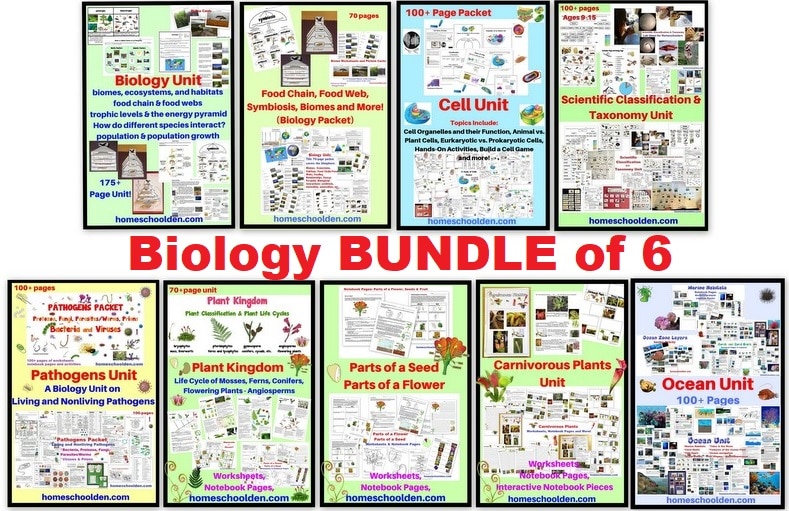
Documentaries that work well with this unit: In fact, the last time when we did this Biology Unit, we used the documentaries documented by David Attenborough: Life and Planet Earth. The kids fell in love with David Attenborough’s narration… and the animal scenes are breath taking! Amazon’s description of Life: Four years in the making, filmed over 3000 days, across every continent and in every habitat, Life is the latest wildlife blockbuster from the BBC’s award-winning Natural History Unit. We also wound up watching Planet Earth and Planet Earth 2 because the kids loved this material so much! Any of these DVD would work well with the Biology Unit — Life, Planet Earth, Planet Earth 2. (affiliate links)
Note: Be sure to get the Life version that is narrated by David Attenborough!! Also, if you look around you can get these on Amazon Prime or get Life and Planet Earth together or Planet Earth and Planet Earth 2 together depending on what you are interested in. (affiliate links)
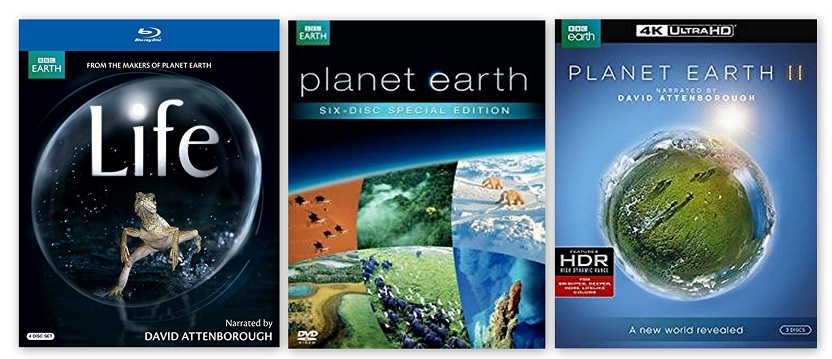
Since we watched those documentaries (above) the last time we did this unit, we are using some new material. ED is going to do a study of animals of the African savanna. I made a new packet of material for her on that (which I just added to the World Animals Packet). (My older two are also doing Biology, but they are using another program as well so they won’t be studying the African savanna.)
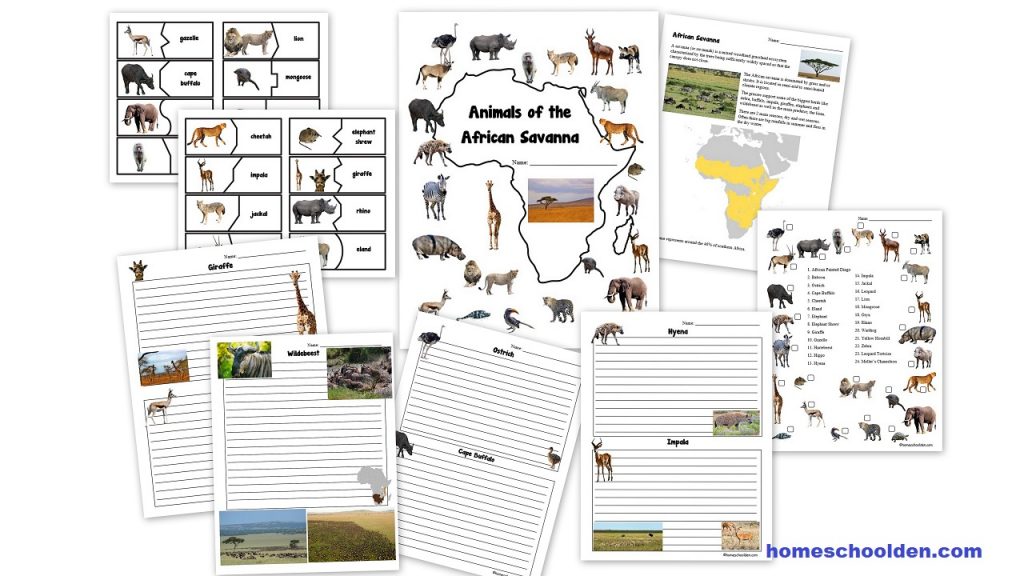
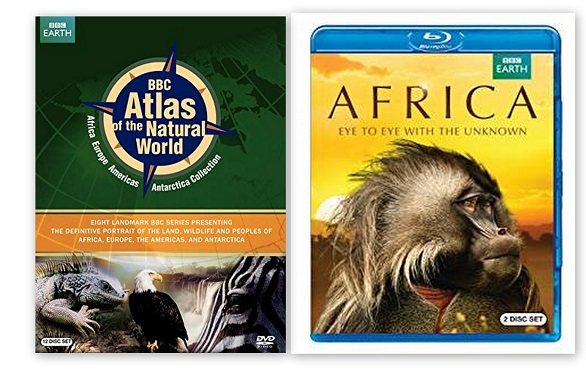
Visit Our Store to see our other packets.
Biology BUNDLE OPTIONS:
Visit this Biology Bundle Page for more details (and lots more pictures!)
$44.99 Biology BUNDLE of 6: 1) Biology Unit (Biomes, habitats, food chains/webs, feeding relationships) 2) Scientific Classification & Taxonomy Packet 3) Ocean Unit & Layers of the Ocean/Ocean Zone Activities 4) Cells Unit 5) Botany Unit 6) New! Pathogens Unit – Bacteria, Protozoa, Fungi, Parasites/worms; Viruses and Prions
Don’t forget to check your PayPal email address for the download link from SendOwl (the delivery service I use)!
$8.99 Biology Unit: Biomes, habitats, ecosystem, biological interactions, feeding relationships (170 pages)
$8.99 Cells Unit (150+ pages) – cell theory, prokaryotic vs. eukaryotic cells, animal vs. plant cells, organelles of the cell, chloroplast anatomy, the layers of a leaf, photosynthesis and more.
$7.99 Botany Packet — (80 pages) Plant Classification, Life Cycle of the Moss, Fern, Conifer, Angiosperms, Parts of a Flower, Parts of a Seed, Seed & Fruit Development, Monocots vs Dicots – plus Carnivorous Plants Mini-Unit
$8.99 Ocean Unit – Layers of the Ocean/Ocean Zone: (100+ pages) Marine Habitats, Coral Reefs, Tide Pools, Water Form Words, Ocean navigation, Features of the ocean floor, salinity, ocean tides & currents, ocean life, bioluminescence & more!
$7.99 Scientific Classification and Taxonomy Packet (100 pages) dichotomous key activity, Linnaeus & the history of classification, learn the Animalia phyla (Annelids, Platyhelminthes, Nematodes, Cnidaria, Animalia, etc.)
$8.99 Pathogens Packet (100 pages) – This unit covers the six major living and nonliving pathogens: bacteria, protozoa, fungi and parasites/worms as well as viruses and prions. The large majority of this packet goes into detail about bacteria and viruses.
Again, you can see the Biology BUNDLE Page for lots more pictures!
Don’t forget to check your PayPal email address for the download link.
Biology: Cell Unit
Cell Unit: (Now more than 150 pages) The Cells Unit covers cell theory, prokaryotic vs. eukaryotic cells, animal vs. plant cells, the organelles of the cell, and now goes into more detail about chloroplast anatomy, the layers of a leaf, photosynthesis, and more.
Biology: Botany Unit
Botany Packet — Plant Classification, Life Cycle of the Moss, Fern, Conifer, Angiosperms, Parts of a Flower, Parts of a Seed, Seed & Fruit Development, Monocots vs Dicots – plus Carnivorous Plants Mini-Unit
Biology: Scientific Classification and Taxonomy Unit
Scientific Classification and Taxonomy Packet: (Newly updated and now over 100 pages)
In this unit, we started off by talking about why we classify things. We learned about the dichotomous key and did a number of activities to understand how they work. We talked about why classification is useful and how we can do that in a way that is organized and logical.

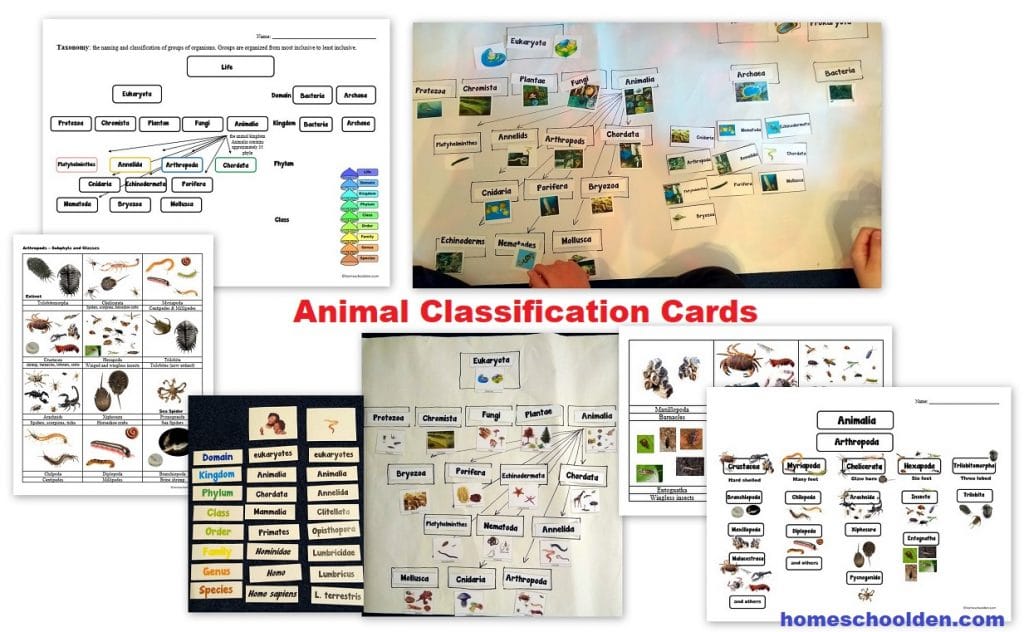

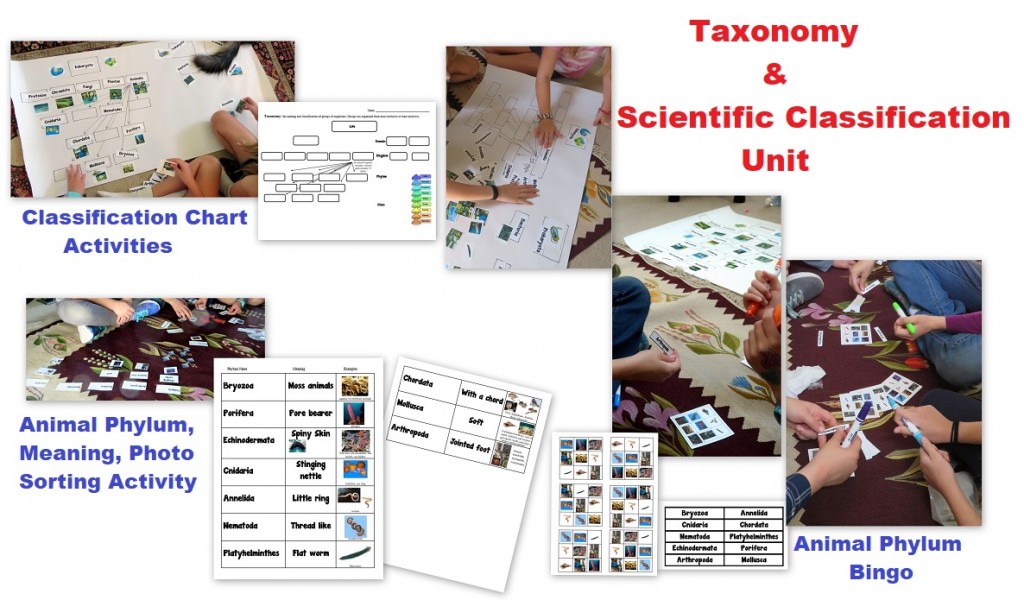
Biology: Ocean Unit
This unit is a study of the hydrosphere — Earth’s oceans, tides, marine life (including bioluminescent critters, and more!)
In our ocean studies we explored
- Marine Habitats
- Coral Reefs
- Tide Pools
- Water Form Words (bay, estuary, lagoon, fjord, etc.)
- Features of the Ocean Floor (trench, seamount, guyot, etc.)
- Ocean Navigation (early navigation with astrolabes & the constellations, modern SONAR)
- Salinity
- Tides (and the phases of the moon)
- Ocean Currents (Surface & Deep Sea Currents)
- Ocean Life:
- Special Body Features
- Fish Body Shape and Movement
- Biological Interactions: Mutualism and Commensalism in the Ocean
- Deep Sea Life – Bioluminescence, Anglerfish
We also talked about the ocean zones and different layers of the ocean again (which we covered three or four years ago).
Pathogens Packet
See more details at the Pathogens Unit Page.
Animal Unit
For younger student, you might want to check out the Animal Unit:
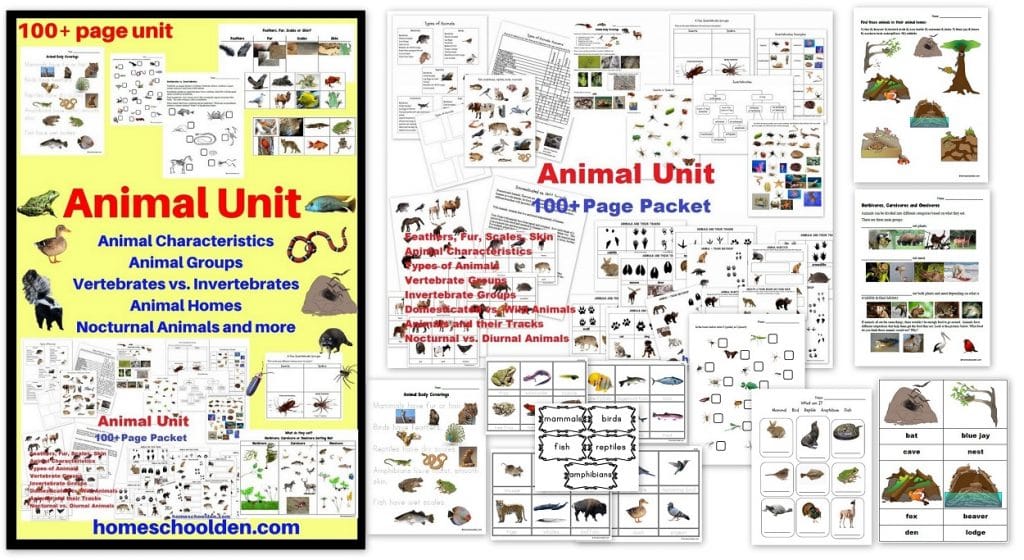
Or you may want check out the Big Animal BUNDLE:
The Big Animal BUNDLE includes 8 packets. 1) Animal Unit, 2) World Animals Packet, 3) Rainforest Packet, 4) Life Cycles Packet, 5) Winter Packet – plus several mini units 6) the Cicadas Packet and 7) the Chameleon Packet. 8) the Wolves Mini-Unit.
These Animal Units can each be purchased individually as well.
Don’t forget to check your PayPal email address for the download link.
You might also be interested in some of our other packets and printables. Visit Our Store for more details.
See you again soon here or over at our Homeschool Den Facebook Page! Don’t forget to Subscribe to our Homeschool Den Newsletter. You might also want to check out some of our resources pages above (such as our Science, Language Arts, or History Units Resource Pages) which have links to dozens of posts. You might want to join our free Homeschool Den Chat Facebook group. Don’t forget to check out Our Store as well. ~Liesl

Disclosure: Please note that some of the links in this post are affiliate links, and at no additional cost to you, I will earn a commission if you decide to make a purchase.
